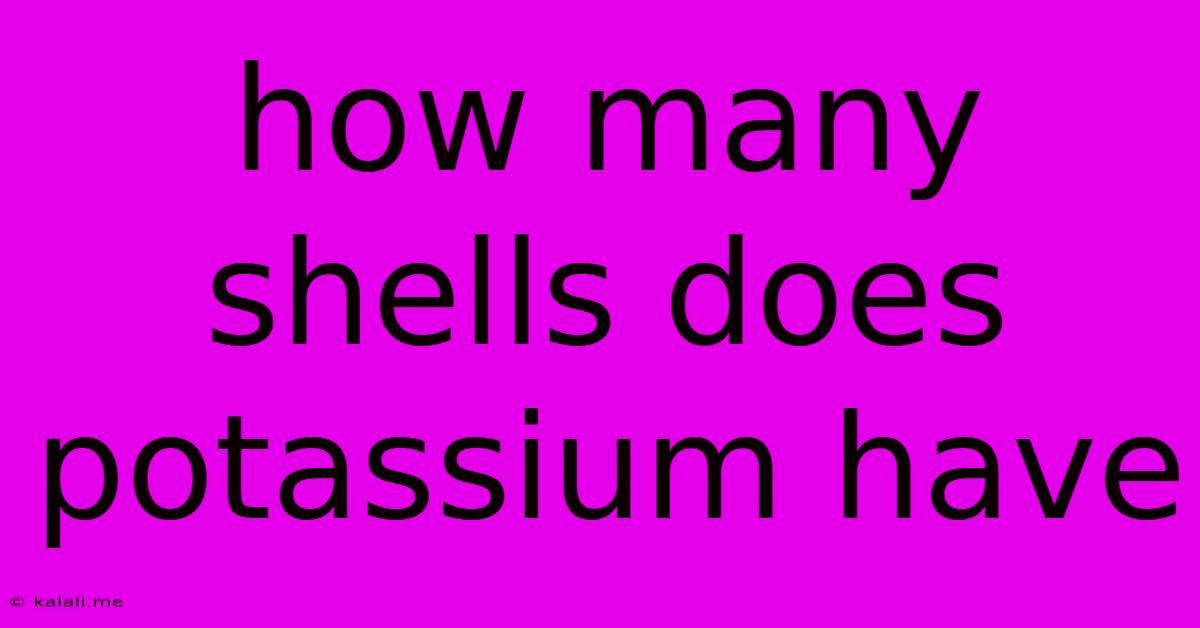How Many Shells Does Potassium Have
Kalali
Jun 13, 2025 · 3 min read

Table of Contents
How Many Electron Shells Does Potassium Have? Understanding Potassium's Electronic Structure
Potassium, a vital element for human health and a common component in fertilizers, boasts a fascinating electronic structure. Understanding its electron configuration helps explain its reactivity and properties. This article will delve into the specifics of potassium's electron shells and provide a clear explanation for all levels of understanding.
Potassium (K), with an atomic number of 19, possesses 19 protons and, in its neutral state, 19 electrons. These electrons are distributed across different energy levels or shells, surrounding the nucleus. The arrangement of these electrons determines the element's chemical behavior and its position in the periodic table.
Electron Shell Distribution in Potassium
The electrons in potassium are arranged in specific shells, each capable of holding a maximum number of electrons. These shells are identified by principal quantum numbers (n). The order of filling shells follows the Aufbau principle and Hund's rule.
- Shell 1 (n=1): This innermost shell can hold a maximum of 2 electrons. Potassium has 2 electrons in its first shell.
- Shell 2 (n=2): This shell can accommodate up to 8 electrons. Potassium possesses 8 electrons in its second shell.
- Shell 3 (n=3): This shell can also hold a maximum of 8 electrons. Potassium has 8 electrons in its third shell.
- Shell 4 (n=4): This is the outermost shell for potassium, also known as the valence shell. It contains only 1 electron.
Therefore, the electron configuration of potassium is 2, 8, 8, 1. This clearly shows that potassium has four electron shells.
Significance of the Outermost Shell (Valence Shell)
The single electron in potassium's outermost shell is crucial in determining its chemical properties. Elements strive for stability, often achieved by having a full outermost shell (octet rule). Potassium readily loses this single valence electron to achieve a stable electron configuration similar to the noble gas argon. This ease of losing an electron makes potassium highly reactive and explains its characteristic properties, including its strong reducing nature and its ability to form ionic bonds with other elements.
Understanding Electron Shells: A Simple Analogy
Imagine the nucleus as the sun and the electrons as planets orbiting it. Each shell represents a different orbit, with shells closer to the nucleus having lower energy levels. The outermost shell, where the valence electrons reside, determines the element’s interaction with other elements.
Potassium's Role in Biology and Chemistry
The reactive nature of potassium, directly linked to its single valence electron and four electron shells, makes it an essential element for various biological processes. Its ability to conduct electricity also finds applications in various chemical and industrial processes.
In conclusion, potassium has four electron shells, with a single electron in its outermost valence shell. This electron configuration significantly impacts potassium's reactivity, its role in biological systems, and its overall chemical behavior. Understanding the electronic structure provides a deeper appreciation of the properties and importance of this crucial element.
Latest Posts
Latest Posts
-
An Electron Is Accelerated From Rest Through A Potential Difference
Jun 14, 2025
-
Greater Than Less Than Calculator Decimals
Jun 14, 2025
-
What Are Two Elements That Are Liquid At Room Temperature
Jun 14, 2025
-
Gpa Requirements For Valdosta State University
Jun 14, 2025
-
At What Temperature Do Celsius And Fahrenheit Scales Coincide
Jun 14, 2025
Related Post
Thank you for visiting our website which covers about How Many Shells Does Potassium Have . We hope the information provided has been useful to you. Feel free to contact us if you have any questions or need further assistance. See you next time and don't miss to bookmark.